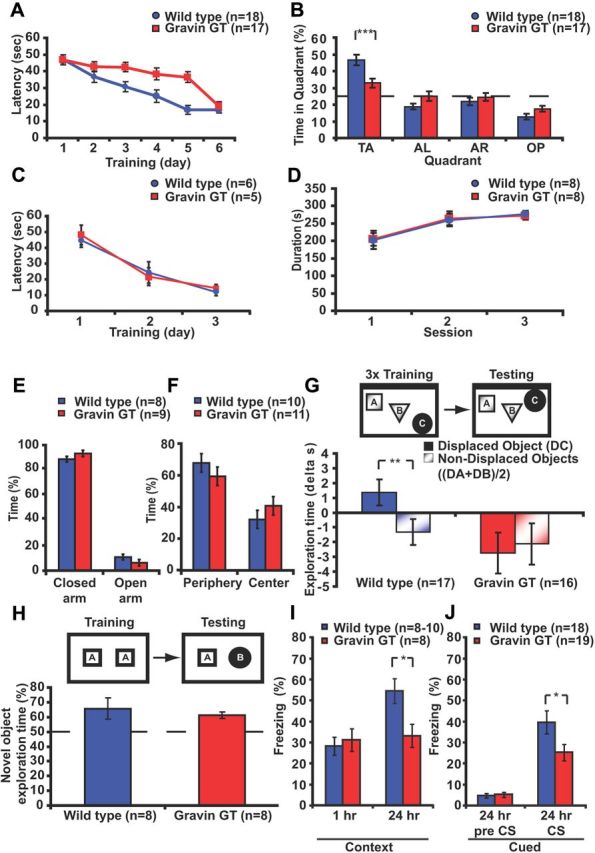Figure 4.

Long-term memory formation is impaired in gravin GT mice. A, In the spatial version of the water maze, gravin GT mice exhibited impairments during training (two-way repeated-measures ANOVA, effect of genotype, F(1,33) = 6.02, p = 0.02) but eventually reached the hidden platform with a latency similar to wild-type littermates (independent-samples t test, p = 0.523). B, During the probe trial, wild-type mice preferentially searched in the target quadrant (post hoc Tukey's test, p < 0.001) in contrast to gravin GT mice (post hoc Tukey's test, p > 0.1, target vs adjacent quadrants). C, Gravin GT mice were not different from wild-type mice on the visible platform version of the maze (two-way repeated-measures ANOVA, F(1,18) = 0.056, p = 0.813; interaction between genotype and day, F(2,18) = 0.240, p = 0.743). D, Motor coordination as assessed by the rotarod test was not altered in the gravin GT mice. Both groups gradually increased the time spent on the rotating rod (two-way repeated-measures ANOVA, effect of day, F(2,28) = 15.634, p = 0.0001). No effect of genotype was found (two-way repeated-measures ANOVA effect of genotype, F(1,14) = 0.001, p = 0.953). E, Gravin GT mice spent a similar time in the open arms of the zero maze as wild-type mice (Student's t test, p = 0.694). F, Gravin GT mice spent a similar time in the center of the open field as wild-type mice (Student's t test, p = 0.388). G, During the test session in the object-place recognition task, wild-type mice exhibited increased exploration time for the displaced object but decreased exploration time for the non-displaced objects (paired t test, p = 0.003). Gravin GT mice exhibited reduced exploration times for both displaced and non-displaced objects (paired t test, p = 0.518). H, During the test session in the novel object recognition task, both wild-type and gravin GT mice preferentially explored the novel object (two-factor ANOVA F(1,28) = 5.806, p = 0.023). No genotype or interaction effect between genotype and object was found (ANOVA, F(1,28) = 0.006, p = 0.936; ANOVA, F(1,28) = 0.661, p = 0.423, respectively). The dotted line indicates no preference. I, Mice were trained in the contextual fear conditioning paradigm. Wild-type and gravin GT mice showed similar freezing levels during the retention test 1 h after training (Student's t test, p = 0.679), while gravin GT mice showed reduced freezing levels during the retention test 24 h after conditioning (Student's t test, p = 0.019). J, In the cued-fear conditioning paradigm, gravin GT mice showed reduced freezing levels during the test session 24 h after training (Student's t test, p = 0.023). TA, Target; AL, adjacent left; AR, adjacent right; OP, opposite. *p < 0.05; **p = 0.003; ***p < 0.001. Error bars indicate SEM.
